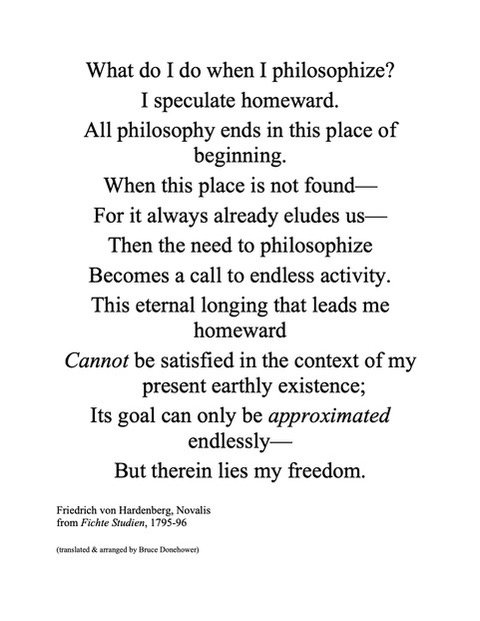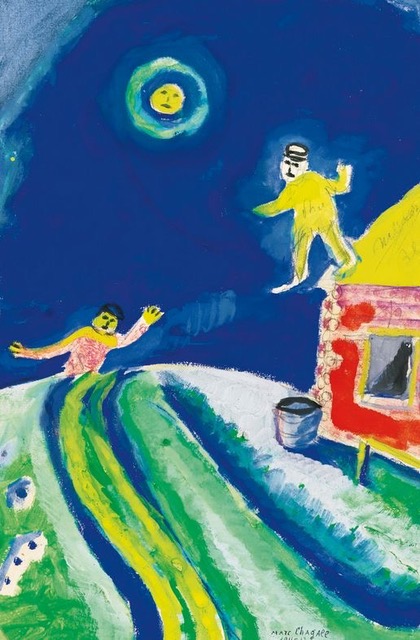Here is a summary of the recent weekly Section for Literary Arts & Humanities meeting of the local group in Fair Oaks, CA. This meeting occurred on May 23, 2020 via Zoom. In this meeting, we continued our exploration of Novalis — with an accent on the color blue. Our next meeting is Saturday, May 30.
Meeting Summary
Too blue for you?
Following the challenges of logging into Zoom, we started our meeting a little late with a verse from the Novalis fragments.
“Inward goes the secret path. Eternity with its worlds, the past and the future, is in us or nowhere. We dream of journeys through the cosmos — is the cosmos not then in us? In us, or nowhere, is eternity with its worlds — the past and the future.”
Patricia then gave us a splendid introduction to the use of the color blue from an art historical perspective. We were treated to a gallery of masterfully curated “blues” from the time of ancient Egypt to the present day.
Truly, blue is a color that soothes the soul! But as Patricia pointed out with a quote from the painter Kandinsky, it also inspires what the romantics such as Novalis called “Sehnsucht” or “yearning.” We haven’t had time yet to unpack this term in our discussions, although I touched on it a few times in the meetings and in the three Branch presentations recently Zoomed. “Sehnsucht” or “unendliche Annäherung” is not simply a mood; it is a heuristic. And the soul mood of blue is, as I might argue, the magic land where poetry meets philosophy — a decidedly critical encounter for early romantics such as Novalis, for example.
What is this longing that arises with the feeling of blue and which leads us like Heinrich to lose ourselves “in sweet fancies” and to dream of “regions far distant” and unknown? These quoted words are from Chapter One in Heinrich von Ofterdingen — and they describe Heinrich’s experience of falling asleep, just before the famous dream of the blue flower. In Chapter Six, as we saw last week, the dream transforms and becomes another dream of erotic/poetic bliss, as Heinrich shares a kiss with Mathilda beneath the blue stream that flows above them. And, marvelously, he again hears the “secret word” — given direct to his mouth by the lips and tongue of Mathilda — the word that will end the false dream of “inverted being” (see the poem in incomplete Part 2 of HvO / “das ganze verkehrte Wesen”). And he beholds…
Well, what, exactly? Dreams within dreams? Where are we going anyway? Always toward home? Excuse me?
Such moods can be annoying, and admittedly they do provoke sharp critical responses, as they did with poet Heinrich Heine who hooted off the romantics and who helped launch them in a barrel down the Rhine to the watery blue as the Lorelei cooed. So much for goopy dreamers! Onward to realistic witty narratives that give us some good old black and blue! No more sentimental goo!
But as Patricia so rightly reminded us with the Kandinisky quote featured next, blue speaks to a part of the human soul attuned to the infinite.
“The deeper the blue becomes, the more strongly it calls man towards the infinite, awakening in him a desire for the pure and, finally, for the supernatural …” — Kandinsky
Other Discussions
Gayle asked an important question: How do we know that the ancients actually perceived the color blue as we today perceive it? Did they see it at all? She cited the famous passage in Homer that describes the “wine-dark sea.” This raises a very important concern — and it’s one, actually, that Owen Barfield investigated in his well-known book Saving the Appearances and elsewhere, but philologically. Back to blue: was there, for example in ancient Egypt, a soul mood blue that corresponds to the mood, say, that Novalis describes in HvO? What does this tell us about human consciousness?
Interesting, too, as a side note, that in German “I am blue” means “I am drunk; I had too much wine.” Our friend Friedrich punned on this tipsy feeling when talking about Sophie. I am referring to the poem that he wrote at the beginning of their relationship, “Anfang,” in which he debates with himself: “is this that I feel for Sophie spiritually true or are these feelings blue, like the intoxication of wine”? I put a stanza from the poem at the end of this summary.
Short of building a Way Back Machine with Mr. Peabody or perhaps time traveling in our astral blue jeans — how do we investigate this hypothetical blue “change of consciousness?” A challenge — true! But, we needn’t reach for morning glory seeds — we have texts! By reading texts — aka literature — we have, as Owen Barfield argued, a methodology of research that allows us, if we accept the premises, to transport ourselves into distant minds, distant times, distant rhymes. It might be fun to start assembling a concordance of blue citations — a common-place book of blues — quotes and references from all types of literature that would help us live into blue — although, as the link below (contributed by Patricia) leads us to understand: the word “blue” appears to be suspiciously AWOL from earlier literature. A blue mystery! Might this blue have something to do with the soul evolution of the human being? Might it be possible that “blue” has a certain spiritual significance for the consciousness soul and for the consciousness soul’s characteristic mood and mission? Is there some brave scholar out there to follow the footsteps of Barfield and investigate blue? Nonsense! If you believe the common view — it’s all just chemicals. Trompe-l’œi. Donne-le au feu!
But as Novalis reminds us in the fragment that we have used as a verse several times and which I unpacked during the presentation of “magical idealism” at the recent Faust Branch meeting:
 Poetry
Poetry
Following this groove with blue, Dan presented an original poem on the theme of blue with some artwork by Andy Warhol.
It is wonderful that creative writing has shown up once more at our Section Meetings! Our Section, after all, had a creative writer (poet, novelist, dramatist) leading its activities at the time of founding — and we should not lose sight that the “beautiful sciences” have creative writing (as we call it today) centrally situated in the Section activities. We’re not a book club, eh?
Toward the end of the evening, during our discussion, Cheryl drew our attention to passages in the Prokofieff book (Eternal Individuality) that shed light on Hardenberg and Sophie. Next week, by the way, Cheryl will share with us her research on Vidar. Thanks, Cheryl! Here are the citations from Eternal Individuality: Towards a Karmic Biography of Novalis.
“Although in her everyday consciousness the 12-year-old Sophie van Kuhn knew nothing about the forces of the imprint of the Luke Mary’s etheric body that worked within her own etheric body, nevertheless these forces rayed forth everywhere around her…what his (Novalis) reason could not explain was felt in all fullness by his heart, deeply imbued as it was with the mysteries of the spiritual world……he was able to approach this purely spiritual experience because he bore an imprint of the astral body of the Nathan Soul in his own astral body.” (198)
“This higher astral body, this spiritual rose within him, led to the ‘heart knowledge’ of the blue flower or spiritual lily in the etheric body of Sophie von Kuhn….And because of the spiritual wedding which had taken place on the Earth, Novalis is in a position to follow this etheric imprint with his soul into the higher spiritual worlds, in the direction of the constellation of the Virgin, the all-embracing cosmic sphere of the Sophia….” (199)
Housekeeping
Finally, some housekeeping. (Gosh, this is getting long — apologies, but we have been meeting weekly — and quite contra-intuitively, a lot has been going on. Things ebb and flow, as we know, and I expect we’ll hit a lull sooner or later or maybe a dead stop — but for now: “scatter abundant seed,” as Novalis recommends.)
“Friends, the soil is poor; we must scatter abundant seed to ensure even a middling harvest.”
1) I recommended Friedrich Hiebel to the group, and Gayle helped me find Dr. Hiebel’s book on Novalis published in English by UNC Press. I included a link to the UNC Press at the bottom of this email. I had thought that the book was only available in German, but that was my bad — I only used the German edition, and I just never bothered to look if it was out in English.
2) We decided that we will leap over chapters 6, 7, 8 and set our sights on a mad dash to the summit: Chapter Nine. This will allow us to explore the famous Klingsohr Fairy Tale and survey the book from the top of the mountain — after which we can choose like Wordsworth on Mount Snowdon how the heck we will work our way back down from the sublime heights. So read Chapter Nine. The Hiebel book will be useful.
3) We will read the incomplete Part 2 of the novel eventually. I included again a link to a free text that includes this section.
4) The Faust Branch asked me for a bibliography of texts that friends could use, following the three Novalis presentations that I gave this month. I will prepare something. But I think the best way to share this valuable information, and the other information that has been accumulating during our work over the past years, is to put up some kind of website — so I will look into that.
Last stanza of poem “Anfang” mentioned in summary:
“Einst wird die Menschheit sein, was Sophie mir
Jetzt ist — vollendet — sittliche Grazie —
Dann wird ihr höheres Bewusstsein
Nicht mehr verwechselt mit Dunst des Weines.”
“But what most attracted his notice, was a tall, light-blue flower, which stood nearest the fountain, and touched it with its broad, glossy leaves. Around it grew numberless flowers of varied hue, filling the air with the richest perfume. But he saw the blue flower alone, and gazed long upon it with inexpressible tenderness.”
— Novalis. Heinrich von Ofterdingen

